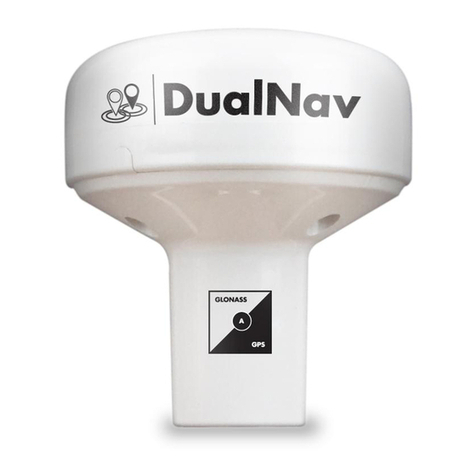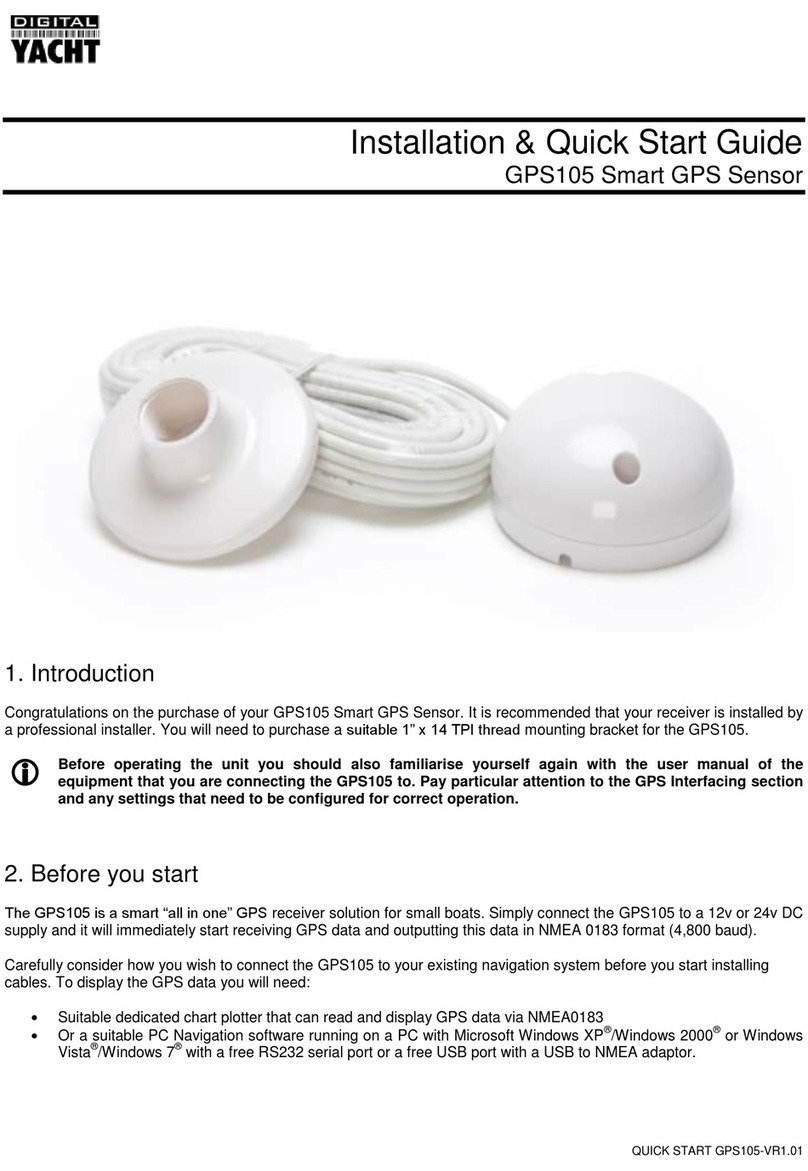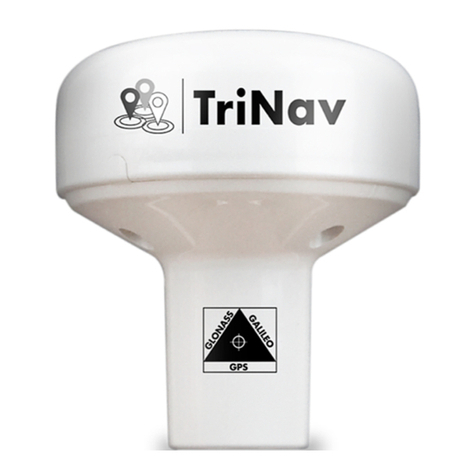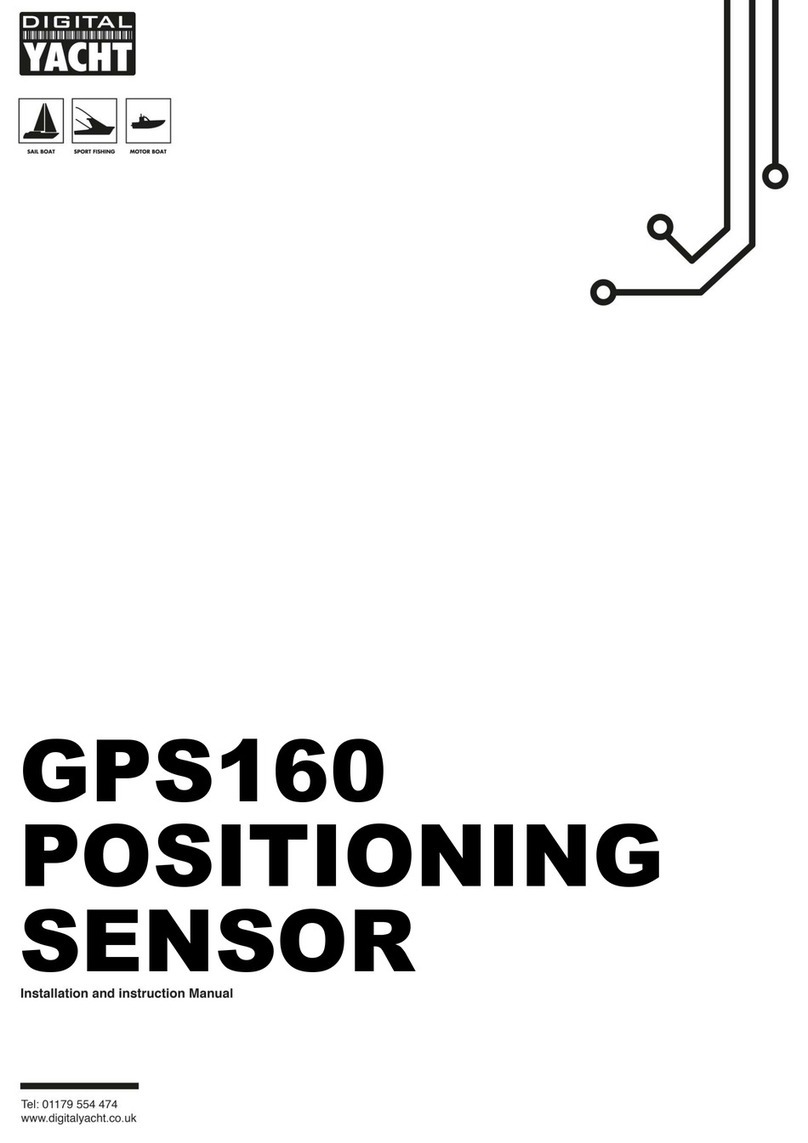DIGITAL YACHT HSC100 Datasheet

QUICK START HSC100-01-VR1
Installation & Quick Start Guide
HSC100 Compass Sensor
1. Introduction
Congratulations on the purchase of your HSC100 Compass Sensor. It is recommended that your compass sensor is
installed by a professional installer.
Before operating the unit you should also familiarise yourself again with the user manual of the
equipment that you are connecting the HSC100 to. Pay particular attention to the Compass Interfacing
section and any settings that need to be configured for correct operation.
2. Before you start
The HSC100 is a smart “all in one” Compass solution for small boats. Simply connect the HSC100 to a 12v or 24v DC
supply and it will immediately start calculating the heading of the boat and outputting this data in NMEA 0183 format
(4,800 baud) or Furuno AD-10 format. The HSC100 outputs compass data at a frequency of ten times a second making it
ideal for smooth radar overlay on chart plotters, „course-up‟ Radar input or for driving an autopilot. It is housed in a water-
resistant enclosure so it can be mounted outside in steel hulled boats.
Carefully consider how you wish to connect the HSC100 to your existing navigation system before you start installing
cables. To display the Compass data you will need:
Suitable dedicated chart plotter or radar that can read and display Compass data via NMEA0183
Or a suitable PC Navigation software running on a PC with Microsoft Windows XP®/Windows 2000®or Windows
Vista®/Windows 7®with a free RS232 serial port or a free USB port and USB to serial port adaptor.

DIGITAL YACHT LTD
GPS105 Quick Start Guide
3. Installation
Before starting installation select a suitable
location for the HSC100 Sensor. The ideal
position for a fluxgate compass sensor is in the
centre of the boat where pitch and roll is
minimised.
The HSC100 should also be mounted as far
away as possible from metal objects that are
regularly moved or electrical cables/equipment.
Effects from fixed metal objects can be
calibrated out, but if a metal object is placed
near or moved away from the sensor after
calibration, inaccuracies could occur.
The HSC100 should be fixed to a vertical
bulkhead in an upright orientation using the
fixing holes shown in the diagram. It does not
matter which direction the HSC100 faces, as
the azimuth can be set to North at any time.
4. Electrical Connections
The HSC100 is supplied with 15m of cable and this should be routed through the vessel to a suitable dry internal location
where it can be connected to the boat‟s DC power system and the equipment it will be interfaced with. The cable can be
shortened, lengthened or joined without problems.
The HSC100 should be connected to the boat‟s DC supply via a 1 Amp fuse. The unit requires 8V to 30V DC supply
voltage. Typical supply current during operation is approx. 25mA. Note that the operation of the LED adds another 10mA
and that during auto-calibration the consumption can be as high as 60mA.
Below are the wiring details for the HSC100 and a diagram showing the two push button switches;
Wiring Colours;
Red
Power + (12v or 24v)
Black
Power –(0v)
Yellow
NMEA Out +
Green
NMEA Out –
White
NMEA In+ (not used)
Brown
NMEA In–(not used)
Violet
Furuno AD-10 Data
Blue
Furuno AD-10 Clock
Screen
Ground
The HSC100 can provide compass data in two industry standard formats; NMEA0183 and Furuno AD-10 format. The
following section explains these two formats.
NMEA-0183
The serial output format is: 4800 Baud, 8 data bits, 1 stop bit, no parity. The compass sends information using the
standard NMEA-0183 sentence „HDG‟: Magnetic Heading, Deviation, and Variation. But note that the information of
Deviation and Variation is not sent and so blank fields are defined by consecutive commas.

DIGITAL YACHT LTD
GPS105 Quick Start Guide
$HCHDG,hhh.h,,,,*ss<CR><LF>
where hhh.h represents the magnetic heading with one decimal place of precision, i.e: 000.0 to 359.9 degrees.
And where ss is the 2 digit checksum .
Furuno AD-10
The HSC100 has a separate, dedicated output in Furuno AD-10 format. This is a proprietary 4 character serial format,
which gives heading in degrees and tens of minutes. The string 0872 represents the heading 87° 20‟ so that the
precision is to 1/6 of a degree. At the same time the HSC100 would be also sending the NMEA data to a precision of
1/10 of a degree.
480µs
100ms minimum
Duration of data is 16 clocks each
high=low=30µs. Total = 480µs.
Frequency of data packets is set by
the interval command. Max = 10Hz
Clock
Data
5. Calibrating the Compass
When any compass is installed the magnetic characteristics of the whole installation affect the way the Earth‟s field
reaches the detector inside the device. Each individual installation will be different and so the HSC100 is equipped with
an auto-calibration routine which corrects for these installation distortions of the magnetic field.
Calibration must always be done with the unit in its final mounted position. The essential point of the calibration is to
remove the influence of nearby pieces of iron and steel –so it is essential that these remain unchanged after calibration.
If any significant iron component is altered –such as the installation of new equipment or replacement of equipment such
as winches or engines –then the calibration must be re-done.
Compass Calibration is best done in calm waters when no other vessels are around. Steer a straight course of around
270º and when safe to do so, press the push button Switch 1 and start a slow and constant turn to starboard. It is
necessary for the boat to be turned clockwise through a full 400º. It is important that the turn is completed at a constant
rate and the turn should take no less than 60 seconds and no more than 180 seconds.
During the auto-calibration process, the Blue Status LED on the HSC100 will flash as follows;
State 1 Un-calibrated long flash
State 2 In the process of calibration continuous
State 3 Calibrated short flash
If something should happen that stops you from safely completing the calibration, such as a vessel approaching or an
obstruction, press and hold both push buttons together for 1 second. This will cancel the calibration and leave the unit in
an un-calibrated state.
If the calibration completes successfully, the HSC100 Status LED should change from being on continuously to short
flashes.
Once calibrated, it is important to zero any alignment offset and this is done by steering the boat to North (000º) as per
the conventional magnetic steering compass or failing this the GPS course over the ground (make sure GPS is set to
display magnetic headings). Once you are happy that the boat is steering a course of 000º degrees (magnetic), press
push button Switch 2.
Calibration and Alignment is now complete.
Table of contents
Other DIGITAL YACHT Accessories manuals






















